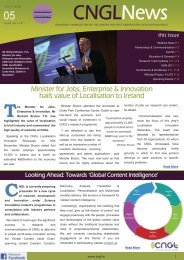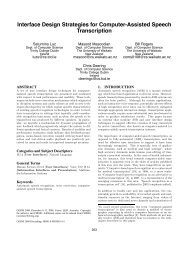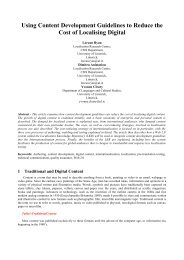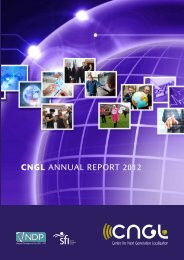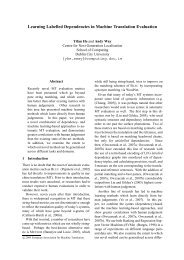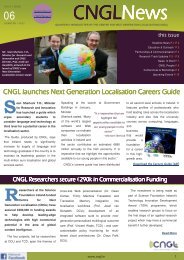Localisation, Internationalisation, Globalisation - CNGL
Localisation, Internationalisation, Globalisation - CNGL
Localisation, Internationalisation, Globalisation - CNGL
Create successful ePaper yourself
Turn your PDF publications into a flip-book with our unique Google optimized e-Paper software.
Translating Vital Information:<br />
<strong>Localisation</strong>, <strong>Internationalisation</strong>, and <strong>Globalisation</strong><br />
Dimitra Anastasiou, Reinhard Schäler<br />
Centre for Next Generation <strong>Localisation</strong>,<br />
<strong>Localisation</strong> Research Centre,<br />
Department of Computer Science and Information Systems,<br />
Limerick, Ireland<br />
{Dimitra.Anastasiou, Reinhard.Schaler}@ul.ie<br />
Summary: This paper deals with <strong>Globalisation</strong>, <strong>Internationalisation</strong>, and <strong>Localisation</strong>; these<br />
terms are often used interchangeably, which is incorrect. <strong>Internationalisation</strong> is the step before<br />
localisation, while globalisation covers both internationalisation and localisation and is<br />
generally considered more as a strategy than a task. In this paper we will focus on one<br />
particular aspect of localisation, i.e. the effect of mainstream localisation efforts on people<br />
whose languages are not covered because they do not represent a market and are thus<br />
deprived of access to vital information. Very often important information to secure the health,<br />
freedom, education, and financial well-being of people does not reach many parts of the world<br />
and is only available in English. This paper raises awareness of inequality with reference to<br />
the digital divide, and describes the humanitarian goal of localisation. We introduce some notfor-profit<br />
organisations and describe the Rosetta Foundation as one example of how to<br />
address the digital divide and the problem of information poverty ignored by current<br />
mainstream localisation efforts.<br />
1. Introduction<br />
<strong>Globalisation</strong>, <strong>Internationalisation</strong>, <strong>Localisation</strong>, and Translation (GILT) are terms which<br />
nowadays are used very often. The borders between them are often blurred, as many people<br />
consider localisation as counterpart of globalisation on the grounds that the former is<br />
"supposedly" based on a local and the latter on a global audience or market.<br />
In this paper we will examine the differences between localisation, internationalisation,<br />
and globalisation (section 2) and then describe in section 3 the main characteristics of the<br />
language-culture combination, called locale. Section 4 elaborates particularly on the need for<br />
localisation, focuses on healthcare, and provides an introduction to some not-for-profit<br />
organisations.<br />
<strong>Localisation</strong> should not be seen only through the eyes of the localisation enterprises as a<br />
process to increase international sales revenues, but also as a helping hand for the people who<br />
have limited or no access to digital content. This lack of important information and access<br />
will be described in section 5 and the Rosetta Foundation which provides solutions addressing<br />
the problem of Information Poverty will be introduced in sub-section 5.1. We close this paper<br />
with a summary in section 6.<br />
2. <strong>Localisation</strong>, <strong>Internationalisation</strong>, <strong>Globalisation</strong><br />
In this section we define the terms included in GILT and illustrate their characteristics and<br />
their main differences.<br />
Translation is the text transfer from a source to a target language; text is everywhere, in<br />
laws, news, academic dissertations, user manuals, advertisements and so on; the list is<br />
endless. Besides, that text is often accompanied by pictures, animations, logos, diagrams, and<br />
other visual effects. We often see that these visual effects change, when they are transferred to
a target language (TL). That is in principle what localisation means: it goes beyond the<br />
translation and adapts the source content to the culture of the place where the translated text is<br />
to be used (called locale – see section 3).<br />
Since the digital revolution in 1970-1980s, the text has become part of the digital content.<br />
The digital content, apart from text, contains also audio, video, images, and software.<br />
Software includes websites, programs, or video games and thus implements graphics,<br />
animation, and many other widgets. The text included in the software should be translated<br />
into a TL and the visual part of the software should be localised according to the preferences<br />
of a locale. <strong>Localisation</strong> is regarded often as "high-tech translation", as localisation addresses<br />
non-textual components of products or services in addition to strict translation. Esselink<br />
(2000) refers to other tasks included in localisation, in addition to translation, such as project<br />
management, software engineering, testing, and desktop publishing.<br />
The <strong>Localisation</strong> Industry Standards Association 1 (LISA), which has corporate clients and<br />
provides business guidelines and multilingual information management standards, defines<br />
localisation as follows:<br />
"<strong>Localisation</strong> involves the adaptation of any aspect of a product<br />
or service that is needed for a product to be sold or used in<br />
another market." 2<br />
We see that this definition focuses on the usage and selling of products in distinct<br />
markets. Now we give the definition of localisation by Schäler (2007), who additionally to<br />
products, focuses on digital content in general:<br />
"[<strong>Localisation</strong> is] the linguistic and cultural adaptation of<br />
digital content to the requirements and locale of a foreign<br />
market, and the provision of services and technologies for the<br />
management of multilingualism across the digital global<br />
information flow." Schäler (2007: 157)<br />
In the aforementioned definition, we notice, among others, the aspects of multilingualism<br />
and digital global information flow. These aspects link local communities and foreign markets<br />
with global ones and this linking is achieved through multilingual websites, software, and<br />
information in general.<br />
As far as internationalisation is concerned, it takes place at the development stage of a<br />
product. According to Schäler (2003: 79), "internationalisation is the isolation of linguistic<br />
and cultural data, so that localisation is performed simply and cheaply". LISA defines<br />
internationalisation as "the process of enabling a product at a technical level for localisation." 3<br />
In other words, internationalisation precedes localisation. LISA states, as a general rule, that<br />
the localisation of a product takes twice as long and costs twice as much if it is not properly<br />
internationalised 4 . As for the people involved, software developers are the people mainly<br />
involved in the internationalisation process.<br />
Combining the two aforementioned processes, localisation and internationalisation, we<br />
come to globalisation. <strong>Globalisation</strong> transforms local or regional phenomena into global ones.<br />
According to Wiegerling (2004: 2), "globalisation as a global integration of markets and the<br />
consideration of a local identity can exist side by side". <strong>Globalisation</strong> is often synonymous<br />
with economic globalisation, it can be defined though in a number of different ways. LISA<br />
1 http://www.lisa.org/, 20.10.2009<br />
2 http://www.lisa.org/Localization.61.0.html, 20.10.2009<br />
3 http://www.lisa.org/Internationalization.58.0.html, 20.10.2009<br />
4 http://www.lisa.org/Internationalization.58.0.html, 20.10.2009
describes globalisation as "the global product development cycle, where internationalisation<br />
includes the planning and preparation stages for a product and localisation the actual<br />
adaptation of the product for a specific market" 5 . Thus globalisation is not a counterpart of<br />
either localisation or internationalisation, but the general umbrella which covers them both;<br />
that is the "industry standard" globalisation model. However, Microsoft's globalisation model<br />
differs in that the terms internationalisation and globalisation are substituted 6 .<br />
At this point we would like to refer to the term called "glocalisation", a portmanteau word<br />
of globalisation and localisation. "Glocalisation" is a neologism meaning the combination of<br />
intense local and extensive global interaction (Wellmann, 2003: 13). He states that "glocal"<br />
shows the human capacity to bridge scales (from local to global) and to help overcome "littlebox"<br />
thinking. Besides, he describes that glocalisation creates new social needs, as there is<br />
need for more funds of desirable resources, along with financial capital, human capital,<br />
organizational capital, and cultural capital. Such network capital includes the fund of people<br />
who provide information, knowledge, material and financial aid, emotional support and so on.<br />
Networked individuals, in their attempt to keep their relationships with friends or family get<br />
to know and learn how to do that, i.e. by means of which sites, etc.<br />
Let us now depict the main differences between the terms "localisation",<br />
"internationalisation", and "globalisation" in the form of a table (see Table 1). We distinguish<br />
them particularly based on their definition, people involvement and performance stage.<br />
Definition<br />
People<br />
Stage<br />
<strong>Internationalisation</strong> <strong>Localisation</strong> <strong>Globalisation</strong><br />
Functional in any Adaptation of The strategy of<br />
language and content products, services, bringing a product or<br />
(linguistic and and digital content service to the global<br />
cultural data) to a culturallinguistic<br />
market, involving<br />
separated from<br />
market sales and marketing<br />
functionality<br />
Software developers,<br />
producers and<br />
authors of digital<br />
content<br />
Development and<br />
design of a digital<br />
product (content) or<br />
service (pre-requisite<br />
for localisation)<br />
Translators,<br />
proofreaders,<br />
software engineers,<br />
project managers,<br />
testers, publishers<br />
Translation and<br />
adaptation of text,<br />
user interface, and<br />
cultural conventions<br />
Marketing and sales<br />
personnel<br />
Bringing to the<br />
market the<br />
internationalised and<br />
localised product or<br />
service<br />
Table 1. Differences between internationalisation, localization, and globalisation<br />
The cooperation between those contributing to the localisation process is vital. Take the<br />
software developers, for instance. They gain from the software publishers‘ side, as they do not<br />
want to take the risk of huge initial production and want to keep the cost low. The relationship<br />
between the clients and the vendors should be open, honest and they should constantly give<br />
feedback to each other. If people cooperate properly, then everybody gains advantage and the<br />
result is as desired.<br />
5 http://www.lisa.org/What-Is-Globalizatio.48.0.html, 20.10.09<br />
6 http://www.google.de/url?sa=t&source=web&ct=res&cd=3&ved=0CBIQFjAC&url=http%3A%2F%2Flocalizat<br />
ionlocalisation.wordpress.com%2F2009%2F04%2F08%2Fwhich-comes-first-globalization-orinternationalization%2F&ei=aLztSuzfIM37_AbBycCTDw&usg=AFQjCNFSjiV3rLoJYXltBCQvVmmALULri<br />
A and http://msdn.microsoft.com/en-us/goglobal/bb688112.aspx, 20.10.09
We would like now to make a further distinction between ordinary (otherwise called<br />
mainstream) and out-of-the ordinary localisation. The former is driven by short-term sales and<br />
return on investment (ROI) considerations and has a mono-dimensional globalisation function<br />
focused on the economic aspects of globalisation while ignoring the social, cultural, and<br />
political aspects. Localisers work mostly with proprietary files, so the relationship between<br />
customers and vendors is one-way, tight, and protected. Ordinary localisation is difficult to<br />
maintain long-term, as proprietary content and technologies will lead to expensive and<br />
politically and culturally inadmissible monopolies.<br />
By contrast, out-of-the-ordinary localisation is driven by disruptive innovation and has a<br />
multi-dimensional globalisation function. Content developers and tool providers promote<br />
open standards, such as Creative Commons for content and OASIS 7 -based standards for<br />
technology. Content developers and service providers become tool and tool-provider<br />
independent, content, linguistic resources and technologies become widely available and the<br />
community can easily become involved in projects through crowdsourcing and communitybased<br />
platforms, thus leading to greater economic activities and wider access to digital<br />
information and knowledge. Crowdsourcing is a neologism for the act of taking a task<br />
traditionally performed by an employee or contractor, and outsourcing it to an undefined,<br />
generally large group of people or community in the form of an open call (see Howe, 2008).<br />
The relationship between the partners is open and there are opportunities given to the<br />
community and not only to the professional paid sub-contractor to participate. The "cascading"<br />
value chain is cut, and middlemen are replaced by open platforms and sharing of digital<br />
content. Collaboration in the out-of-the-ordinary localisation becomes not just possible, but<br />
also affordable, since monopolies, as in mainstream localisation, are no longer involved.<br />
3. Locale<br />
"One country, one language, one culture" was a common motto many years ago which we<br />
can now find it only seldom and particularly in terms of historic matters. Nowadays we prefer<br />
the motto of the Asia Online 8 company which is the following: "The World speaks one<br />
language – Yours", implying that every language should have penetration on every aspect of<br />
life, everywhere in the world, and the Web is an effective means to achieve that.<br />
As aforementioned, locale is this combination of language and culture where the localised<br />
digital content, products, and services are used and sold. Neither a language nor a culture<br />
alone can form a locale. There can be a language spoken in more than one country, that means<br />
that there are many different languages in one single country. Moreover, there can be more<br />
than one different culture in the same country. Take the Greek language, for example. Greek<br />
is spoken not only in Greece, but also in the countries where Greek immigrants are. That<br />
means that we do not have a Greece-locale or a Greek language-locale, but an Australian-<br />
Greek locale or a German-Greek locale, to name just a few. Both the Greek language and the<br />
culture are influenced by the local Australian and German language and culture.<br />
In different locales there are linguistic, cultural, and technical differences. Although<br />
English is spoken in both the United Kingdom and the USA, differences in spelling exist on<br />
either side of the Atlantic Ocean. Take for example the UK spelling of "localisation", which is<br />
"localization" in the USA.<br />
The adaptation of colours, icons, and graphics to the target product or service is essential,<br />
in order not to offend the local audience or overstate a situation. An example of a cultural<br />
non-adaptation is the "Ben & Jerry" Black & Tan ice-cream which introduced and quickly<br />
removed this flavour from the Irish market in 2006, apologising to their Irish customers.<br />
Black & Tan in the US means a mixture of Guinness and cream; in Ireland, however, Black &<br />
7 http://www.oasis-open.org/home/index.php, 20.10.09<br />
8 http://www.asiaonline.net/Default.aspx, 20.10.09
Tans was the name of a particular vicious invasion army which occupied the country in the<br />
early 20 th century.<br />
A locale provides cultural conventions which are data formats, dates (full and abbreviated<br />
names for weekdays and months), number formats (symbols for the thousands separator and<br />
decimal point), times (indicators for 12-hour time), and currency symbols 9 . Just to provide an<br />
example of how important the measurement conventions are, "Gimli Glider" was a Boeing<br />
767 jet which in 1983 ran out of fuel in mid-flight because of two mistakes in figuring the fuel<br />
supply of the airline's first aircraft to use metric measurements.<br />
Wade (2009) supports the locale of one, which is very inspiring and evolving idea. Based<br />
on this idea, every person in a locale is unique with specific needs, preferences, and<br />
competences. According to Wade (2009: 27), "presenting tailored content can provide user<br />
improvement both in terms of ease of understanding of the content as well as ease of<br />
application of the information in performing user tasks." We definitely agree with the locale<br />
as a repository of shared user needs and preferences, but we strongly believe in the research<br />
towards supporting the existing unique mentalities inside a locale.<br />
4. Need for <strong>Localisation</strong><br />
The need for localisation nowadays is immense from every aspect, as it brings benefits to<br />
industries, customers, and government, simply to everyone. Even more importantly, many<br />
times localisation saves lifes in countries where people have limited or not access at all to life<br />
saving information in their native language.<br />
From the one hand, the industries have a need for localisation, as their products should be<br />
sold everywhere in the world. The profit is much more when the product is adapted to the<br />
needs and preferences of a locale. From the other hand, customers will buy a product more<br />
easily if the website and the user manual of the product are in their own language, just to give<br />
an example. The websites should not only be multilingual, but should be interesting with<br />
attractive effect and adapted to the target locale users' preferences; in other words, they have<br />
to be personalised.<br />
Apart from the linguistic issues, there are also physical and technological issues behind<br />
the need for localisation. As far as the physical issues are concerned, automobiles sold in<br />
Australia, the United Kingdom, Ireland, India, Japan, and much of southern Africa need to<br />
have their steering wheels on the right side of the vehicle, while in all the other parts of the<br />
world the steering wheel is on the left side. Also, various volt power levels are distinct in<br />
some countries, e.g. the electrical equipment sold in the United States and Canada requires<br />
120-volt power, most of Japan requires only 100 volts and most of the rest of the world uses<br />
220- or 230-volt power. Another example is the different computer keyboard layouts. As for<br />
the technical issues, supporting some local languages may require extra engineering work.<br />
The character encoding and the internationalisation in general, is very important, for example,<br />
for East Asian languages. Languages which are written from right to left, such as Arabic and<br />
Hebrew, must be taken into account and not be ignored.<br />
On a higher level, the governments also gain advantage from localisation. Particularly, the<br />
Social Enterprise Coalition in the UK has been very strong on their vision of a localised<br />
policy environment supporting prosperous and cohesive communities 10 . The government localisation<br />
agenda includes among others, greater community participation, flexibility, and<br />
organisational focus on users.<br />
9 http://publib.boulder.ibm.com/infocenter/wbihelp/v6rxmx/index.jsp?topic=/com.ibm.wics_developer.doc/doc/a<br />
ccess_dev/access_dev141.htm, 20.10.2009<br />
10 http://www.dta.org.uk/activities/campaigns/communityenterprise/localisation.htm, 20.10.09
4.1 Healthcare<br />
We will now focus on the urgent need for localisation in areas, both geographical and<br />
domain specific, which are currently ignored by mainstream localisation. For example, signs<br />
warning children in Afghanistan of land mines are written only in English, a language foreign<br />
to the children playing in these areas. In healthcare, important information, from the<br />
description of medicines to medical equipment user manuals, is just not available in a<br />
sufficient number of languages. In many countries, foreign healthcare workers must orally<br />
translate surgery manuals, so that they can be understood by local medical teams. Moreover,<br />
information about preventing mother-to-child transmission of HIV is unavailable in many<br />
local languages. Very often, young rural mothers lack access to health and nutritional<br />
guidelines in their language, so they cannot combat malnutrition in their children. According<br />
to the former director of UNICEF 11 , James Grant, two billion people today lack access to<br />
healthcare. As a result, 17 million people die each year and 80% of these preventable deaths<br />
occur because of a lack of access to healthcare information.<br />
Furthermore, in 2008 it was announced that some 5,500 patients had received overdoses at<br />
a French hospital between 1999 and 2006; 715 had received ‗dangerous doses‘ and 5 had<br />
died. 12 A report by the French Nuclear Safety Authority 13 blamed the overdoses in part on the<br />
French technicians who had incorrectly calibrated radiotherapy equipment when working<br />
from untranslated English operator guides. 14<br />
These figures illustrate how immense the need for localisation is, independent of shortterm<br />
return on investment considerations. For example, some of the world's best known and<br />
most successful not-for-profit organisations which provide access to heathcare to those who<br />
need it most, have only limited funds to pay for commercial mainstream localisation services<br />
and are in dire need of a service that is based on social entrepreneurship instead, putting<br />
people before profits:<br />
<br />
<br />
<br />
<br />
Doctors Without Borders/Médecins Sans Frontières (MSF) 15 : an international<br />
medical humanitarian organisation working in more than 60 countries. It received<br />
the 1999 Nobel Peace Prize;<br />
Pharmacists Without Borders (PSF) 16 : wishes to help populations in need to<br />
organise their medical distribution networks and to assure the proper management<br />
of essential medications;<br />
the well project 17 : a not-for-profit corporation, conceived, developed, and<br />
administered by HIV+ women and those who are affected by this disease;<br />
Handicap International 18 : works in around 60 countries worldwide to make a<br />
positive difference to the lives of disabled people; it has been a co-winner of the<br />
1997 Nobel Peace Prize;<br />
World Information Transfer 19 Inc.: a not-for-profit, non-governmental<br />
organisation in General Consultative Status with the United Nations, promoting<br />
environmental health and literacy.<br />
11 http://www.unicef.org/, 20.10.09<br />
12 Statement by French Health Minister Roselyne Bachelot, reported by AFP, 22 April 2008.<br />
13 http://www.french-nuclear-safety.fr/, 20.10.09<br />
14 Final report of the French Nuclear Safety Authority (ASN)<br />
http://rpop.iaea.org/RPOP/RPoP/Content/Documents/Whitepapers/rapport_IGAS-ASN.pdf<br />
15 http://www.doctorswithoutborders.org/, 20.10.2009<br />
16 http://www.psfcanada.org/en/index.html, 20.10.2009<br />
17 http://www.thewellproject.org, 20.10.2009<br />
18 http://www.handicap-international.org.uk/, 20.10.2009<br />
19 http://www.worldinfo.org/, 20.10.2009
With the activities of these organisations, people can survive and live better. To give just<br />
and example, the number of people in Mozambique on anti-retroviral treatment, the lifesaving<br />
medication for people living with HIV and AIDS, was 86,000 by the end of 2007, up<br />
from 8,000 in 2004 20 .<br />
It is noteworthy that a lot of translation and interpreting is done on the ground and is not<br />
captured by central administration by some of the non-governmental organisations.<br />
5. <strong>Localisation</strong> against Digital Divide and Information Poverty<br />
Nowadays many of us get often really frustrated if we cannot chat, download our favourite<br />
video, or share our pictures – and that in few minutes, as the Internet connection is slow or the<br />
webpage that we need information from is currently out of service. This frustration as a result<br />
of "bad" connection exists only in the western countries and some other parts of the world, as<br />
most parts of the world do not have internet connectivity at all.<br />
Some languages are called minority languages although they are spoken by million<br />
people, but have no penetration on the Web in contrary to some other languages which<br />
without many speakers have achieved a great presence in the Internet, e.g. Norwegian. The<br />
percentage of Internet users per language can be found at the "Internet World Stats" website 21 .<br />
English is the top language in the Internet with 464 millions of users, followed by 321<br />
Japenese and 131 Spanish. In the first quarter of 2009 there are estimated 1,596,270,108<br />
Internet users. As for Spanish, there are 132,963,613 Spanish speaking people using the<br />
Internet. Out of the estimated 411,631,985 world population that speaks Spanish, only 32.3 %<br />
use the Internet. It is noteworthy that the number of Spanish speaking Internet users has<br />
grown 631.3 % in the last eight years (2000-2009). In the same years, the growth in Internet<br />
for English is 237.2 %, while for Chinese is almost 4.5 times higher with 1,018.7%. Another<br />
fact, reported by the China Internet Network Information Center 22 , is that the Internet users in<br />
China (338 million) are more by 30 million than the total population of US.<br />
However, Internet is only one part of the digital world and although the Internet grows,<br />
still many countries lack the technology. In order to have Internet, PCs are necessary and<br />
these are unavailable in many "developing" and impoverished countries; then, to a higher<br />
level, access to the internet is restricted to those who have money to pay for it. Many people<br />
do not even have a telephone connection: half of the population has never made a phone call –<br />
only 3% out of 80% of total population has a telephone connection.<br />
That leads to the digital divide, i.e. the gap between people with effective access to digital<br />
and information technology and those with very limited or no access at all; the global digital<br />
divide refers to differences in technology access between countries or the whole world. The<br />
lack of technology generally causes lack of useful information and knowledge. Gender,<br />
income, race groups, and locations are some of the classification categories of the digital<br />
divide.<br />
There are enough associations, foundations, and charity organisations which help people<br />
survive by translating life saving information, live a better life after having treated diseases,<br />
and also bridge the digital divide giving the opportunity to excluded communities to become<br />
familiar with technology and the digital world.<br />
After we referred to some important health helping organisations, we would now like to<br />
introduce another not-for-profit organisation, The Institute of <strong>Localisation</strong> Professionals 23<br />
(TILP) which is the representative body for localisation professionals. It has the primary aim<br />
of developing professional practices in localisation globally. TILP is owned by its members<br />
20 www.irishaid.gov.ie, 20.10.2009<br />
21 http://www.internetworldstats.com/stats7.htm, 20.10.2009<br />
22 http://www.cnnic.org.cn/en/index/index.htm, 20.10.2009<br />
23 www.tilponline.org, 20.10.2009
and is registered in Ireland. It offers the Certified <strong>Localisation</strong> Professional Programme (CLP)<br />
and is the reference point at global level for the localisation industry and those requiring<br />
information about it. TILP cooperates closely with localisation companies, government<br />
departments and agencies, researchers and students, as well as the media and international<br />
consultancy firms.<br />
The Rosetta Foundation 24 is another not-for-profit organisation registered in Ireland which<br />
is designed to combat another type of global poverty, a lack of access to basic information on<br />
health, education, and other essential services. The Rosetta Foundation aims to make<br />
information available to people worldwide regardless of their income levels, cultural<br />
background, and language.<br />
The Rosetta Foundation was launched during at AGIS 2009 25 at the University of<br />
Limerick over three days in September, 21 st to 23 rd . At AGIS 2009, there were many<br />
presentations and discussions about information poverty and how this problem could be<br />
solved by out-of-the-ordinary localisation efforts. The president of the Rosetta Foundation is<br />
Reinhard Schäler and the vice presidents are Smith Yewell and John Papaioannou. The<br />
Rosetta Foundation is a spin-off and supported by the University of Limerick and the Centre<br />
for Next Generation <strong>Localisation</strong> 26 (<strong>CNGL</strong>) project. It receives significant support from<br />
localisation service provider Welocalize 27 .<br />
We aforementioned that access to information can save lives, preserve people's liberty and<br />
support their education and financial well-being. <strong>Localisation</strong> (or the lack of it) can make the<br />
difference between prosperity and poverty, freedom and captivity, and, ultimately, life and<br />
death. The Rosetta Foundation combats information poverty by enabling access to<br />
information in any language. It wants to make this possible by developing and deploying an<br />
open source intelligent translation and localisation platform and will use "Globalsight 28 ", the<br />
translation management system of the company Welocalize, as a backbone. This platform will<br />
be available to the translation and localisation community.<br />
Smith Yewell, chief executive of Welocalize and board member of The Rosetta<br />
Foundation referred to The Rosetta Foundation as "a commendable, wide-reaching initiative<br />
that is helping extend the benefits of the translation industry to the people that most need it".<br />
The Rosetta Foundation works with those who want to provide equal access to<br />
information across languages, independent of economic or market considerations, including<br />
localisation and translation companies, technology developers, not-for-profit and non<br />
governmental organisations. One of the partners is Translators without Borders 29 which was<br />
created in 1993 by the translation company "Eurotexte" to provide free translations to<br />
humanitarian organisations. Lori Thicke is the co-founder of "Eurotexte" and Translators<br />
without Borders. Andrä AG 30 , PROMT 31 and Alchemy 32 are also important partners of The<br />
Rosetta Foundation. They deploy a part-time administrator and have donated significant<br />
pieces of technology to the foundation. Another supporter of The Rosetta Foundation is Asia<br />
Online. Asia Online provides its innovating automated translation software technology based<br />
on Statistical Machine Translation (SMT) technology to The Rosetta Foundation. By 2012,<br />
half of all internet users will be from Asia, yet information in their own language represents<br />
less than 14% of the internet; thus Asia Online is working towards a goal of eliminating<br />
information poverty in many developing markets.<br />
24 http://www.therosettafoundation.org/, 20.10.2009<br />
25 http://www.agis09.org/, 20.10.2009<br />
26 www.cngl.ie, 20.10.2009<br />
27 http://www.welocalize.com/english/index.aspx, 20.10.2009<br />
28 http://www.globalsight.com/, 20.10.2009<br />
29 http://tsf.eurotexte.fr/index-en.shtml, 20.10.2009<br />
30 http://www.andrae-ag.de/EN/index.htm, 20.10.2009<br />
31 http://www.promt.com/, 20.10.2009<br />
32 http://www.alchemysoftware.ie/index.html, 20.10.2009
6. Summary<br />
We started this paper with the distinction between globalisation, internationalisation,<br />
localisation, and translation. <strong>Localisation</strong> could be regarded as "high-tech" translation, as it<br />
tranfers not just textual elements, but any type of digital content to the target language or<br />
locale. <strong>Internationalisation</strong> precedes localisation, by making the product easily localisable.<br />
<strong>Globalisation</strong> focuses on the strategy to bring a product or a service to target markets and is<br />
related to business processes and models.<br />
We described the meaning of locale and explained its linguistic, cultural, and technical<br />
characteristics. The spelling, the colours, and the measurement conventions are some of these<br />
characteristics. <strong>Localisation</strong> helps enterprises to increase their revenues by selling their<br />
products in more countries and to more customers by adapting these products linguistically<br />
and culturally.<br />
However, today, mainstream localisation efforts focus on profitable markets and ignore<br />
those who are most in need of access to knowledge and information. Many people die because<br />
important medical information is not translated into their language. Doctors without Borders<br />
is one of the not-for-profit organisations which help people in need; Translators without<br />
Borders is a not-for-profit organisation translating many documents for Doctors without<br />
Borders. In order for these organisations to scale up their services and make vital information<br />
available in more languages, they need access to better technology and linguistic resources.<br />
The Rosetta Foundation, a spin-off of the <strong>Localisation</strong> Research Centre at the University<br />
of Limerick, Ireland, and the <strong>CNGL</strong>, a major research initiative supported by the Irish<br />
Government, aims to provide the framework supporting non-governmental organisations<br />
(NGOs) to make vital information on healthcare available to individuals all over the world<br />
irrespective of their social status, linguistic, cultural or religious background, and<br />
geographical location. Reinhard Schäler (2009: 11), founder of The Rosetta Foundation,<br />
explains: "our initiative to develop an open source translation and localisation platform with<br />
GlobalSight as a backbone will widen the narrow focus of current mainstream localisation and<br />
bring the digital world closer to the three quarters of the world‘s population who currently do<br />
not have access to it."<br />
Combating poverty is not an easy task, it is time-consuming and has to be cost-effective.<br />
However, there can be no better reward for any work accomplished than that of helping<br />
people to survive. Localisers can help people realise their entitlement to health, education,<br />
water and health service, provide security from violence, and end extremes of discrimination<br />
and inequality. Information about and knowledge of these areas is already widely available,<br />
but not in the languages spoken by those who most need to have access to it. Charitable<br />
organisations and social entrepreneurship in localisation and translation, open-source<br />
platforms, and volunteers willing to do humanitarian translation 33 can bring an end to global<br />
information poverty.<br />
7. Acknowledgments<br />
This research is supported by the Science Foundation Ireland (Grant 07/CE/I1142) as part of<br />
the Centre for Next Generation <strong>Localisation</strong> at the University of Limerick.<br />
33 ―The term humanitarian translation covers a broad spectrum of activities. It can describe the aid, and the<br />
reasons for it, in language the international community — the media or donor organizations — can understand.<br />
Or it can be part of the aid itself, as in a medical worker‘s need to communicate with the patient he or she is<br />
treating.‖ (Thicke, 2002)
References<br />
Esselink, B., (2000), A Practical Guide to <strong>Localisation</strong>, Amsterdam: Benjamins.<br />
Howe, J., (2008), Crowdsourcing, Why the Power of the Crowd Is Driving the Future of<br />
Business. Crown Business.<br />
Schäler, R., (2009), "UL bringing information to the world", in: Limerick Leader, September<br />
16, 11.<br />
Schäler, R., (2007), "Localization", in: Encyclopedia of Translation Studies, Baker, M. and<br />
Saldanha, G. (Eds.), second edition, 157-161.<br />
Schäler, R., (2003), "Für einen erfolgreichen Einsatz von Sprachtechnologien im<br />
Lokalisierungs-bereich", in: LDV Forum, Volume 18, Number 1/2, 2003, 78-102.<br />
Schäler, R., (2002), "The Cultural Dimension in Software <strong>Localisation</strong>", in: <strong>Localisation</strong><br />
Focus, Vol. 1, Issue 2.<br />
Thicke, L., (2002), "The humanitarian face of translation", in: Multilingual, Vol. 13, Issue 4,<br />
34-36.<br />
Wade, V., (2009), "Supporting a Locale of One", in: Proceedings of the LRC Conference XIV,<br />
<strong>Localisation</strong> in the Cloud, 27.<br />
Wellman, B., (2002), "Little Boxes, Glocalisation, and Networked Individualism", in: Digital<br />
Cities II, edited by Makoto Tanabe, Peter van den Besselaar, and Toru Ishida. Berlin:<br />
Springer-Verlag, 2002, 11-25.<br />
Wiegerling, K., (2004), "<strong>Localisation</strong> versus <strong>Globalisation</strong> – Claim and Reality of Mobile and<br />
Context-aware Applications of the Internet", in: International Center for Information Ethics<br />
(ICIE), Volume 2, 1-7.



![CNGL Annual Report 2009 [pdf - 6.5 MB]](https://img.yumpu.com/50459787/1/184x260/cngl-annual-report-2009-pdf-65-mb.jpg?quality=85)
